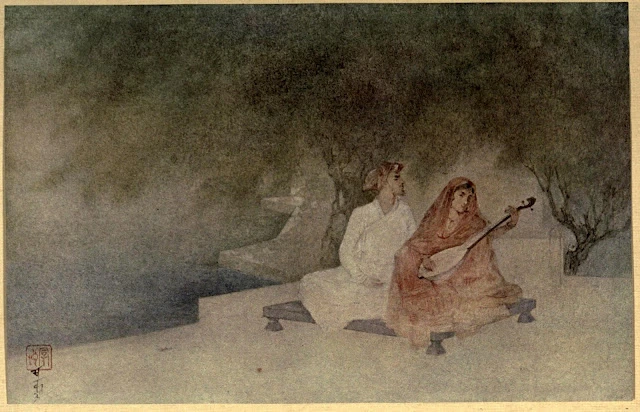(Photo: Painting by Rabindranath Tagore’s : Nishat( نشاط), Nishat means Joy in Persian)
‘With his pursuit of Persian in his early years’ he ‘was proud of Islam’s contribution to Indian culture, of which he considered it an integral part.”61
Edward Thompson
The impact of Islamic thoughts in general and the Persian Sufi tradition in particular on Tagore was significant, which is mostly ignored by critics.
In Bengal, the educated men and women were obsessed with spiritual issues during Tagore’s childhood,
Calcutta, the cultural capital of 19th century Bengal was the rendevous of Persian poets, and a host of Persian poets flourished in the city *56
At the time, the entire composite culture of northern India was steeped in both Persian literary models and the ideals of Persian Sufism.57
Therefore, it comes as no surprise that there was significant interest in the Persian language, literature studies and Sufi teachings in the literary and mystical circles of Tagore’s father and grandfather.
There are so much Islamic content and ideals in Tagore’s writings that he can be called a Muslim without hesitation.*
Spirituality and metaphysical debates permeated the literary culture of 19th and early 20th Calcutta.20
Tagore was raised in an intellectual milieu in which Bengali philosophical, theological, and literary writings were permeated with Islamic-Iranian theological and religious concepts.
Many of the foremost intellectuals and mystics of Tagore’s lifetime knew Persian and were as well versed in the Sufi classics in Persian.
Tagore was far from being a secular intellectual basking in the pleasures of the mind at the expense of the spirit.
He maintained regular exercises of meditation.
His prose and verse were steeped in mystical sentiments and metaphysical disquisitions.
In his introduction to Gitanjali, Tagore’s friend, the Irish poet W. B. Yeats, records how “every morning at three—I know, for I have seen it—he sits immovable in contemplation, and for two hours does not awake from his reverie on the nature of God.”*22
Tagore confirms -in a letter in 1921- the importance of meditation in his life.
He acknowledges his debt to the spiritual practice of daily worship, which was part of his upbringing.*23

When Albert Einstein asked him if he believed in the Divine as isolated from the world, Tagore replied, “Not isolated. The infinite personality of Man comprehends the Universe. There cannot be anything that cannot be subsumed by the human personality, and this proves that the truth of the Universe is human.”95
Portrait of physicist Albert Einstein (1879 – 1955) and Indian poet Rabindranath Tagore (1861 – 1941), circa 1925. (Photo by Martin Vos/Hulton Archive/Getty Images)
Tagore’s preoccupation with the social problem in India led him to seek out the universal elements of Islam for a workable synthesis between Islam and Hinduism.
He thought of this synthesis comprehensible to all humankind.
Tagore dominated the Bengali literary stage for more than fifty years, from the last decade of the 19th century until his died in 1941.30
Indeed he was the main Renaissance man behind the “Bengali Renaissance,” which took place at the time.26
“We speak of it (those years) as the Age of Rabindranath.”27
Ezra Pound, referring to the ‘Age of renaissance’ in Bengal, 1912
19th Century Calcutta; The Rendevous Of Persian Poets
Tweet
Dr Leonard Lewisohn notes that ‘although Persian Sufi ideas constitute a significant feature of Tagore’s philosophical and mystical thought, these aspects are generally disregarded by critics of his writings*.
In this series we will know more about the Rabindranath Tagore family, get familiar with his pedagogy, and the widespread Persian culture of Bengal before the division into East and West Pakistan, and the role of Persian Islam in the Indian reform of Brahmo Samja.
- Hafez and Rabindranath Tagore
- Persian; the language of Bengal until British arrvide in 19th century
- Persian sufism and Indian reform; Ram Mouhan Roy (1772-1833)
- Imam Ali’s followers in a princely family; Rabindranath Tagore
- From avoiding schools to winning the literary Nobel prize
- Calcutta (19th century); the rendevous of Persian poets
- Rabindranath Tagore’s trip to Shiraz to visit Hafez (1932)
- Why did Tagore renounced his Knighthood
- Hungry Stones; an excerpt of a short story by Rabindranath Tagore
- Shiraz 1932; Tagore meditating beside the tomb of Hafez
Suggested readings and references:
Special thanks to Dr Leonard Lewisohn from the University of Exeter for his research that contributed to the main body of this series adaptation. Additional materials were sourced from Professor Emeritus Irfan Habib’s, and Dr Beatrice Teissier’s publications. Sentences showing an asterisk (*) above may be traced to the provided research materials containing over 145 Parsian and English academic references.
- Rabindranath Tagore’s Syncretistic Philosophy and the Persian Sufi Tradition, Leonard Lewisohn, University of Exeter, 2017, Published by Penn State University Press
- TEXTS FROM THE PERSIAN IN LATE EIGHTEENTH-CENTURY INDIA AND BRITAIN: CULTURE OR CONSTRUCT? Beatrice Teissier, Oriental Institute, Oxford, 2009, Published by Taylor & Francis, Ltd.
- Jallianwala Bagh Massacre, Irfan Habib, 2019, Published by Social Scientist
